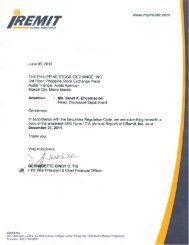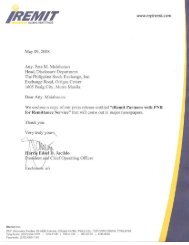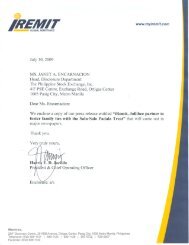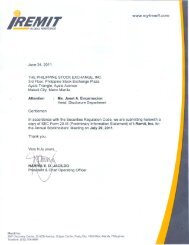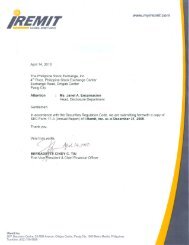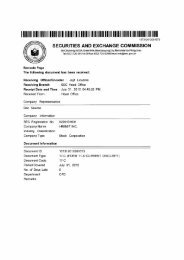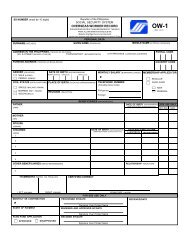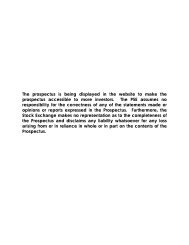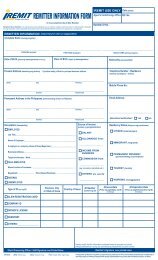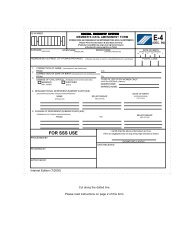SEC Form 20-IS - iRemit Global Remittance
SEC Form 20-IS - iRemit Global Remittance
SEC Form 20-IS - iRemit Global Remittance
Create successful ePaper yourself
Turn your PDF publications into a flip-book with our unique Google optimized e-Paper software.
- 10 -<br />
life of the financial instrument or, when appropriate, a shorter period to the net carrying amount of<br />
the financial asset or financial liability. When calculating the EIR, the Parent Company estimates<br />
cash flows from the financial instrument (for example, prepayment options) but does not consider<br />
future credit losses. The calculation includes all fees and points paid or received between parties<br />
to the contract that are an integral part of the EIR, transaction costs and all other premiums or<br />
discounts.<br />
Once a financial asset or a group of financial assets has been written down as a result of an<br />
impairment loss, interest income is recognized thereafter using the rate of interest used to discount<br />
the future cash flows for the purpose of measuring the impairment loss.<br />
Dividends<br />
Dividend income is recognized when the Parent Company’s right to receive payment is<br />
established.<br />
Rebates<br />
Rebates pertaining to refunds of bank service charges are recognized upon collection.<br />
Costs and Expenses<br />
Costs and expenses encompass losses as well as those expenses that arise in the course of the<br />
ordinary business activities of the Parent Company. The following specific recognition criteria<br />
must also be met before costs and expenses are recognized:<br />
Cost of services<br />
This includes all expenses associated with the specific delivery fees. Such costs are recognized<br />
when the related delivery fees have been recognized.<br />
Operating expenses<br />
Operating expenses constitute costs incurred related to advertising and administering the business<br />
and are recognized when incurred.<br />
Taxes and licenses<br />
This includes all other taxes, local and national, including real estate taxes, licenses and permit<br />
fees included under ‘Other operating expenses’ in the parent company statement of income.<br />
Retirement Benefits<br />
The Parent Company has a noncontributory defined benefit retirement plan administered by a<br />
trustee, covering its permanent employees.<br />
The retirement cost of the Parent Company is determined using the projected unit credit method.<br />
Under this method, the current service cost is the present value of retirement benefits payable in<br />
the future with respect to services rendered in the current period.<br />
The liability recognized in the parent company balance sheet in respect of defined benefit<br />
retirement plan is the present value of the defined benefit obligation at the balance sheet date less<br />
the fair value of plan assets, together with adjustments for unrecognized actuarial gains or losses<br />
and past service costs. The defined benefit obligation is calculated annually by an independent<br />
actuary using the projected unit credit method. The present value of the defined benefit obligation<br />
is determined by discounting the estimated future cash outflows using interest rates on Philippine<br />
government bonds that have terms to maturity approximating the terms of the related retirement<br />
liability. Actuarial gains and losses arising from experience adjustments and changes in actuarial<br />
assumptions are credited to or charged against income when the net cumulative unrecognized<br />
*SGVMC116501*



